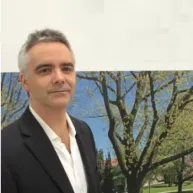Organic Chemistry
The challenging architectures pharmaceuticals and natural products require insightful strategies to efficiently synthesize them. More often than not, scientists can only realize leaps in efficient synthesis by developing or incorporating new methods. We develop strategies to synthesize pharmaceutical drugs which incorporate enantioselective catalysis. Development of these reaction sequences is important because they transform inexpensive prochiral organic starting materials into high-value chiral advanced building blocks.
- New methods of synthesis: Without this, drug developers will not investigate these medicines because they would cost too much to synthesize. We have identified new ways to synthesize (R)-Pristiq, ( )-O-desmethylvenlafaxine, an antidepressant, in the highest yield known to date. Furthermore, we achieved the first enantioselective synthesis of a leading Alzheimer’s research drug, a d-secretase modulator (GSM).
- Morphine: We are currently focusing on the efficient synthesis of morphine, with the goal of developing new morphine family-based analgesics. We rely on a critical enantioselective intermolecular cascade reaction, among others, to achieve synthesis. The cascade reaction partners are diverse in nature and this flexibility provides several synthetic pathways to complete a morphine synthesis. A successful outcome would involve synthesizing morphine using the shortest enantiopure route to date (thirteen steps).
- Cascade reactions: While not new to chemical thinking, cascade reactions have not been sufficiently exploited for pharmaceutical drug synthesis. We are investigating cascade reactions based on Michael-Henry and Michael-Henry-third reactions. These enantioselective cascades have historically been catalyzed via enamine intermediates or partial deprotonation of Michael pronucleophiles. Our ultimate goal is to trigger an intermolecular cascade reaction which installs the entire carbon framework of morphine and simultaneously sets the absolute and relative stereochemistry at most stereocenters of morphine.
- We synthesized (R)-Pristiq, a commercial antidepressant.
- We also synthesized an Alzheimer’s research drug, a d-secretase modulator (GSM-1).
- We focused our medicinal chemistry efforts on identifying morphine-family analgesics.
Prof. Nugent’s group comprised one postdoctoral researcher, one doctoral candidate, and six undergraduate researchers. The research was funded through a German Research Foundation grant.
- Invited contribution to a Special Collection on Organocatalysis: T. C. Nugent, A. E. de Vos, I. Hussain, H. A. E. D. Hussein, A 2000 to 2020 Practitioners Guide to Chiral Amine Based Enantioselective Aldol Reactions: Ketone Substrates, Best Methods, in Water Reaction Environments, and Defining Nuances, Eur. J. Org. Chem. 2022, 7, eLocator: e202100529.
- T. C. Nugent, H. A. E. D. Hussein, S. Ahmed, F. T. Najafian, I. Hussain, T. Georgiev, M. K. Al-Joumhawy, Carboxylate Salt Bridge-Mediated Enamine Catalysis: Expanded Michael Reaction Substrate Scope and Facile Access to Antidepressant (R)-Pristiq, Adv. Synth. Catal. 2017, 359, 2824–2831.
- F. N. Tehrani, K. I. Assaf, R. Hein, Casper M. E. Jensen, T. C. Nugent, W. M. Nau. Supramolecular Catalysis of a Catalysis-Resistant Diesl-Alder Reaction: Almost Theoretical Acceleration of Cyclopentadiene Dimerization inside Cucurbit [7]uril, ACS Catalysis 2022, 12, 2061–2269.
- T. C. Nugent, F. Goswami, I. Hussain, H.A.E.D. Hussein, A. Karn, and S. Nakka, Harnessing Additional Capability from in Water Reaction Conditions: Aldol versus Knoevenagel Chemoselectivity, Adv. Synth. Catal. 2021, 363, 3539–3545.
- A. Sadiq and T. C. Nugent, Catalytic Access to Succinimide Products Containing Stereogenic Quaternary Carbons, ChemistrySelect 2020, 5, 11934–11938.

